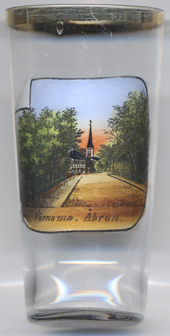

|
| SVERIGE | SWEDEN |
| län: Jönköping |
 Värnamo, historically known as Wernamo, is situated at an elevation of 175 m on the river Lagan just north of the lake
Vidöstern, about 72 km south of the provincial capital Jönköping and about 335 km southwest of the Swedish capital
Stockholm. It is the seat of Värnamo Municipality and has a population of about 19,800 (2020).
Värnamo, historically known as Wernamo, is situated at an elevation of 175 m on the river Lagan just north of the lake
Vidöstern, about 72 km south of the provincial capital Jönköping and about 335 km southwest of the Swedish capital
Stockholm. It is the seat of Värnamo Municipality and has a population of about 19,800 (2020).
Värnamo traces its history back to a village in the medieval age; the first written mention of Warnamo dates from 1236. It came into existence as a village to the eastern side of a fordable place over the Lagan, a river that for large parts is difficult to travel by. Värnamo came to be the centre of Östbo Härad, an archaic form of judicial district, and thus a seat of trade and commerce. When Värnamo became a köping in 1659 it was given formal rights to host markets, falling under the jurisdiction of the city of Jönköping. The town of Värnamo was insignificant for a long time, but with the Swedish population growth and industrialization in the 19th century it expanded, becoming an independent köping in 1859. Dense forests and industrial water power spurned the furniture industry and forges run by water power. The Swedish railroad nets spurred to enhance its industrial life, leading to a boost of the population in the early 20th century. Consequently, it was given stad (city) status in 1920.
 Värnamo church (Swedish: Värnamo Kyrka) [left, no. 4593: background] is used by the
local Lutheran church community. The first church building already existed in the Middle Ages and was expanded in 1683. In 1775 a new church was built,
which proved to be too small in the 19th century. After another new building was decided in 1862, the construction of the present church took place
in 1872–1874 based on a design by the architect Albert Törnqvist. A restoration was carried out in 1964. In 1972 the church received a new organ.
Stained glass windows created in 1898 and a baptismal font from the 13th century are noteworthy.
Värnamo church (Swedish: Värnamo Kyrka) [left, no. 4593: background] is used by the
local Lutheran church community. The first church building already existed in the Middle Ages and was expanded in 1683. In 1775 a new church was built,
which proved to be too small in the 19th century. After another new building was decided in 1862, the construction of the present church took place
in 1872–1874 based on a design by the architect Albert Törnqvist. A restoration was carried out in 1964. In 1972 the church received a new organ.
Stained glass windows created in 1898 and a baptismal font from the 13th century are noteworthy.
The bridge  Åbron [left, no. 4593: foreground] stands at the place where in former times there
was the best ford across the river Lagan. Here it was flat enough for people and animals to cross the river. The first information about a bridge over the
Lagan dates back to the 18th century. At that time there was also a customs hut where you had to pay a fee to cross the bridge to the other bank of
the river. The customs money was used to maintain the bridge. The bridge fund was discontinued in the 1850s. In 1836 it was decided to build a stone bridge
(the one depicted on this glass) across the Lagan. In 1942 it was replaced by a modern bridge.
Åbron [left, no. 4593: foreground] stands at the place where in former times there
was the best ford across the river Lagan. Here it was flat enough for people and animals to cross the river. The first information about a bridge over the
Lagan dates back to the 18th century. At that time there was also a customs hut where you had to pay a fee to cross the bridge to the other bank of
the river. The customs money was used to maintain the bridge. The bridge fund was discontinued in the 1850s. In 1836 it was decided to build a stone bridge
(the one depicted on this glass) across the Lagan. In 1942 it was replaced by a modern bridge.
[https://en.wikipedia.org/wiki/V%C3%A4rnamo; https://en-sg.topographic-map.com/map-zq3ftj/V%C3%A4rnamo/;
https://www.familysearch.org/en/wiki/V%C3%A4rnamo_Parish,_J%C3%B6nk%C3%B6ping,_Sweden_Genealogy;
https://de.wikipedia.org/wiki/Kirche_von_V%C3%A4rnamo;
https://www.naturkartan.se/de/jonkopings-lan/abron]
![[scale]](lineal.jpg)